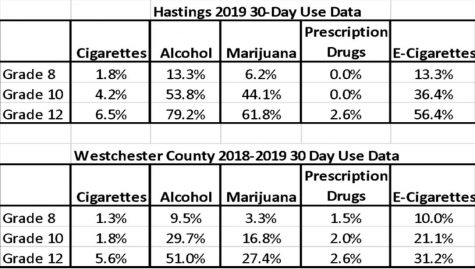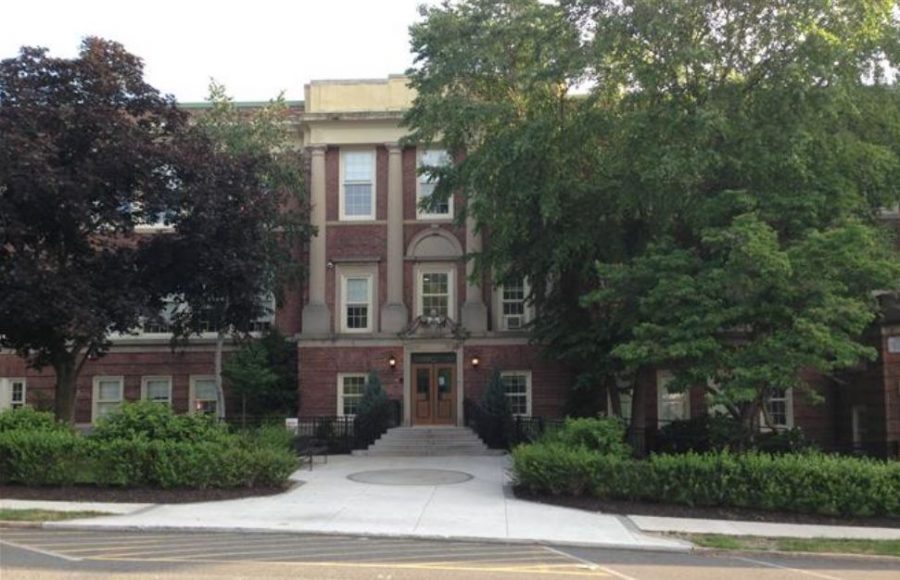Is Hastings Really a “Druggie” Town?
December 21, 2021
With the marijuana dispensary being a popular topic in the village, many community members have segued into a discussion about Hastings High School’s unusually high reported drug usage. But is the drug problem in Hastings’ schools really worse than in other schools in Westchester?
I spoke with Mr. Adipietro, the principal of Hastings High School, and Linda Fosina, the coalition coordinator at the Hastings Community Substance Misuse Prevention Coalition, to find out more.
The WAY Coalition, for which Ms. Fosina works, collects data on youth drug and alcohol use every two years and surveys students about their substance use over the past 30 days. Students in three grades were surveyed in 2019 and once again this December, although data from the recent survey is not yet available.
From the first survey, in 2019, Ms. Fosina’s team assembled these two charts outlining reported drug usage in our school as compared to student reported drug use of Westchester students in general:

Ms. Fosina said she is “thankful that Hastings’s students recognize the dangers of prescription drugs and cigarettes” but is concerned with the use rates for alcohol, marijuana and e-cigarettes. She is hopeful that the coalition, which has recently received federal funding, will be able to help the community and is also hopeful that recent efforts in the community to address the issue will show in the results of the new survey. She also said that according to research done by ONDCP (Office of National Drug Control Policy), many communities with drug and alcohol coalitions have had usage rates decrease significantly.
In the course of her work, Ms. Fosina has explored possible causes for the high rates of drug use in Hastings. She asserts that while “drug use can be influenced by many things including accessibility, friend’s behaviors, media, self-medication and boredom,” one major cause the Coalition has identified is “parental and community acceptance” of drug use in Hastings.

Ms. Fosina realizes that while the rates in Hastings for certain drugs are higher than the county average, these statistics do not represent the entire county average, since many schools in Westchester do not collect data.
Ms. Fosina and the Hastings High School administration have discussed possible solutions to high rates of reported drug usage among Hasting students. They believe that “the community must work together to develop specific strategies that will work here, in Hastings.” This is why the coalition has multiple sectors that connect with like local government, law enforcement, and healthcare workers.
According to Ms. Fosina, the use of illegal drugs nationally among teens is way down, except for marijuana, which has stayed about the same. Alcohol use has not changed significantly in the past five years, and cigarette smoking data did not change much from 2019-2020. However, in all three grades in Hastings, prevalence has reached near historic lows (highs?) after dropping four-fold since the 1990’s.
Ms. Fosina believes that youth drug use is a serious problem. She states that “we know that delaying substance use until after adolescence significantly reduces the likelihood of developing a substance use disorder.” For reason such as these, she is excited that the community is interested in working together to create a healthier community.
Ms. Fosina wants to tell the readers of The Buzzer that our “generation has taken on many important issues – and [is] hopeful this will become one of them.” The risks of adolescent drug use are considerable: not only can it affect developing brains, but it can also lead to addiction later.
Mr. Adipietro agreed with Ms. Fosina that too often people in Hastings have accepted drug use as being acceptable for teens.
I asked Mr. Adipietro how he feels about the possible opening of dispensaries in the town based on the marijuana statistics. He believes that while these two things aren’t completely aligned, marijuana use is on the rise nationally and that some of the issue goes back to its acceptance in the Hastings community. If a dispensary were to open, he believes it would send a message that marijuana usage is okay for underage children.
Mr. Adipietro does not expect that the upcoming survey will yield different findings, but he is thankful that our students are honest about their usage in these surveys as this gives us something to work with.
The crux of the issue, according to Mr. Adipietro, is all about educating students on the dangers of drugs. It’s about sending a message that we aren’t going to turn our heads away from this problem.


















